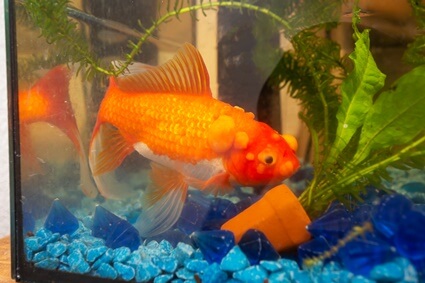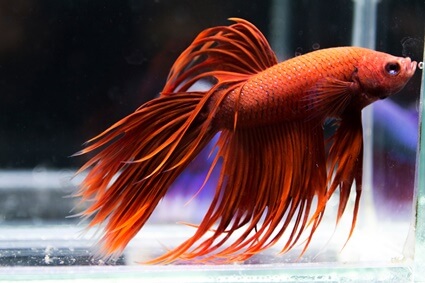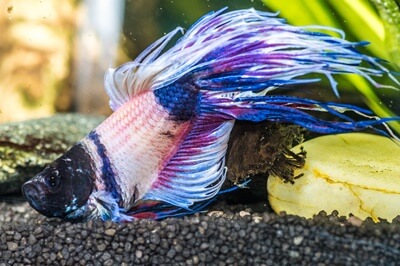When you have a tank of fish, you’ll deal with death more often than you’d like.
While you can’t pick up fish and comfort them like other pets, you can make their final hours more comfortable by optimizing their environment.
To make a dying fish comfortable, do the following:
- Ensure the tank’s temperature and water quality are optimal.
- Keep the tank out of sunlight or draughts.
- Clean the tank to minimize health hazards.
- Provide hiding spots in the form of plants, accessories, and rocks.
- Quarantine the fish in a hospital tank so that it can die peacefully.
In severe cases of pain and distress, consider euthanizing the pet fish. To do so humanely, use a clove oil bath or Alka Seltzer, which leads to a quick, painless death.
What Are the Signs of a Dying Fish?
Before dying, fish display several behaviors that signify their imminent death.
The symptoms vary depending on the cause of death, but common signs include:
Gasping for Air
Fish that can’t breathe properly due to a lack of dissolved oxygen in the tank gasp at the surface.
This is most commonly due to increased ammonia and nitrite levels. The water doesn’t hold enough oxygen for the fish to breathe, so they head to the water’s surface to find oxygen.
Eventually, the stress will be too much for the fish, and they’ll die.
According to the Florida Department of Agriculture and Consumer Services, other factors that affect the amount of oxygen in the water include:
- Temperature.
- Salinity.
- Atmospheric pressure.
The fish will die due to a lack of oxygen, struggling to breathe before this happens.
Changes in Appearance
If you observe changes to the fish’s appearance, it likely has a disease or sickness. In many cases, they can arise suddenly and without warning, signifying the fish is near death.
Dying fish may develop:
- White spots on the body or fins.
- Discolored gills.
- Bulging eyes.
- Skin lesions or sores on the body.
Many forms of sickness and disease are contagious, spreading to all the tank’s inhabitants.
Loss of Appetite
When fish are about to die, they become stressed and lose their appetite. Fish need protein to stay strong and healthy. Without enough, they’ll become weak and die.
Appetite loss is most commonly caused by:
- Unsanitary water conditions.
- Vitamin deficiencies.
- Illnesses, including hole-in-the-head disease, fin rot, and ich.
- Stress.
- Constipation.
Just before fish die, they’ll stop eating and become noticeably thinner.

Abnormal Swimming Patterns
Dying fish begin exhibiting strange swimming patterns, indicating they’re unwell. Sick fish start swimming sideways, upside down and struggle to swim altogether.
You can tell the difference between erratic and abnormal swimming, as fish will appear unhealthy and stressed simultaneously.
Fish swimming erratically are exercising or escaping tank mates because they have the energy to do so.
Fast Gill Movements
Some diseases cause the gills to become covered by a mucus secretion, causing breathing difficulties.
Consequently, you’ll notice the fish breathe quicker than usual because they can’t consume enough dissolved oxygen in their lungs.
Rapid breathing is also the result of high ammonia and incorrect pH levels, which kill fish.
Behavioral Changes
Fish show their personalities based on how they swim, interact with each other, and their activity levels. You’ll learn the fish’s behavior by monitoring their behavior in the tank.
If any exhibit strange behaviors and act differently, the fish is likely dying.
Color Fading
Many fish lose their color when close to death due to a lack of nutrients and oxygen.
If the water parameters in the tank aren’t suitable or you position the tank somewhere too dark, they begin to turn white. This indicates they’re close to death.
Color issues can also be due to:
- Nutritional deficiencies.
- Poor oxygen levels.
- Stress.
- Illnesses.
- Infections.
When fish become stressed, their endocrine system secretes corticosterone.
The Journal of Fish Biology explains how this is a significant stress hormone responsible for color fading. However, color loss can be part of the aging process.
How To Comfort A Dying Fish
Fish are much-loved family pets. Some fish pass quickly before you can do anything about it. Others become sick, and their health gradually declines.
To ease their suffering and find out what to do when a fish is dying, follow these steps:
Regulate Water Temperature
As fish age and develop illnesses, they become more susceptible to stress due to temperature changes.
Older, sick fish can’t regulate their temperature very well. They’re also less active, so they struggle to warm up and need help to stay comfortable.
Stress is among the leading causes of death in fish and can expedite the dying process. Slight temperature changes are expected, but minimize them to avoid an uncomfortable end.
You can achieve this by doing the following:
- Keeping the fish tank out of the sun.
- Placing it away from draughts, air vents, and open windows.
- Maintain the temperature of the room your tank is in.
- Cover the tank to retain heat.
Keep the temperature of the fish tank at the higher end to stop them from becoming too cold.
The younger, active, healthy fish can tolerate a slight temperature rise. However, ensure the water doesn’t get too warm because the dissolved oxygen will decrease, risking the lives of the healthy fish.
Maintain Water Quality
Keep the dying fish comfortable by maintaining the quality of the water.
Tropical fish tanks fare best when the pH is between 6.8 and 7.5. Any changes to these levels can cause the fish to become stressed, sending them into pH shock.
If you allow the ammonia and nitrite levels to rise, the fish will have an uncomfortable few final days.
Ammonia poisoning is uncomfortable and often painful, causing your fish to develop burns and breathing difficulties.
Keep testing the water to ensure the parameters are stable and act quickly if compromised.
Keep Out of Sunlight
Direct sunlight causes a harmful algae bloom. Algae make conditions uncomfortable for dying fish and take over the whole tank, unbalancing the ecosystem.
You can also avoid an algae bloom by doing the following:
- Reduce the light.
- Remove decaying matter to control the nutrients.
- Add aquatic plants.
- Introduce algae-eating plants.
Avoid changing conditions while you have dying fish, as they’ll experience discomfort.
Clean The Tank
Fish need a clean living space to be healthy. Dying fish need the same thing to prevent them from becoming uncomfortable. Dirty tanks aren’t just unpleasant to look at but can be a health hazard.
Several things can make the tank dirty, including:
- Fish waste.
- Rotting food.
- Decaying plants and leaves.
Due to the rising ammonia and nitrites, the amount of oxygen is reduced, so it’s difficult for the fish to breathe. This can exacerbate sickness or health issues, causing unnecessary suffering.
Rest
Dying fish must get adequate rest. A sick fish won’t have the energy to swim and move out of the way of other fish, so keep the tank in a quiet and peaceful room.
Fish can hear sound well, so noisy pets or children tapping on the tank will be stressful.
If there aren’t enough hiding spaces for the dying fish to retreat, add some plants, rocks, and other decorative accessories, giving it room to be alone.
How To Help A Fish Die Peacefully
If you notice the fish is dying in the aquarium slowly and appears in distress, you may consider euthanasia to ease its pain. This is essential for pain avoidance in fish.
Consider these euthanasia methods:
Clove Oil Bath
According to the American Veterinary Medical Association, clove oil is recommended as a humane way to kill dying fish.
Clove oil contains eugenol, an anesthetic agent that puts your fish to sleep before it painlessly succumbs to the ingredients in the bath.
To create a bath, do the following:
- Add a dose of 400 mg/l to water and mix it to emulsify the oil.
- If it doesn’t dissolve well, mix it with hot water and let it cool.
- Transfer the dying fish to the water and observe it to ensure it loses consciousness.
After a short while, the breathing should cease, and the fish will succumb to hypoxia.
The timescale of death varies between fish, but leave it in the solution for at least two hours or overnight. Use a magnifying glass to monitor for signs of life before removing the fish and burying it.
Alka Seltzer
Euthanizing the fish with Alka Seltzer is quick and painless.
When the tablets combine with water, the citric acid and sodium bicarbonate create a chemical reaction that causes carbon dioxide bubbles to form. It removes dissolved oxygen, killing the fish.
Once you add the fish to the water, it stops breathing within seconds, slipping away. There is thrashing, but this is a natural reaction to the chemical solution.
Leave the fish in for 10 minutes after it stops moving to ensure it’s dead.
Euthanasia is only a last resort when the fish is genuinely suffering.
Should I Remove A Dying Fish from The Tank?
If one of your fish is dying, remove it from the main tank and quarantine it.
When setting up a new tank for the dying fish, replicate the aquarium conditions and provide a few hiding spaces to make the fish feel comfortable.
There are several reasons for quarantining a dying fish, including:
Reducing Stress
The main benefit of removing your dying fish from the main tank is that it stops it from becoming stressed out by the busyness of the aquarium.
When they’re in a tank with other fish, they must move out of the way, hide, and compete for food.
There’s also the risk of a dying fish due to being bullied by tank makes. If aggressive fish notice that a fish isn’t as active as it used to be, they may start asserting dominance.
Stress speeds up the process, but not before it makes sick fish even more unwell.

Stops Sickness Spreading
It’s not always easy to tell what the fish is dying from. It could be age or a severe health condition. If the disease is infectious or contagious, the rest of the tank is at risk of infection.
Quarantining a sick fish allows you to hand-feed it, ensuring it gets the nutrition it needs. It also enables the fish to swim in peace without the risk of stress and other triggers.
Prevents Decay
Moving it to another tank means the decaying body won’t pollute it. Decaying and rotting matter contributes to rising ammonia and nitrite levels, polluting the water and poisoning the fish.
It doesn’t take long for poor water quality to affect all fish in the aquarium. While they may not develop health conditions, they’ll become stressed.
How To Dispose of A Dead Fish
Remove the dead fish from the tank as soon as it dies. If you don’t, it’ll decompose and cause the ammonia and nitrite levels to rise, risking the lives of other fish.
Before removing the dead fish, check that it’s deceased.
Sometimes, sick fish appear dead, but their bodies have slowed to conserve energy. While it may look deceased, it has extreme lethargy.
Behavioral Ecology and Sociobiology describe how some fish exhibit thanatosis (death-feigning). Cichlids and betta fish are prone to adopting this behavior.
To determine whether your fish is dead:
- Check for signs of breathing.
- Observe the eyes. If they’re cloudy or motionless, the fish is dead.
- Feel the body for stiffness.
- Check for a foul odor, which is a sign of decay.
- See if the fish is floating or sinking in the tank.
When disposing of dead fish, don’t flush it down the toilet. This also causes problems for local wildlife.
Instead, there are other disposal methods you could use, including:
Burial
You can choose a backyard or potted plant burial. Burying the fish somewhere close by makes owners feel more comforted, and the decaying body provides nutrients for plants and flowers.
Bin
If you don’t have a garden or dislike the idea of burying fish, you could put it in the waste bin. While this isn’t a sentimental burial method, it gets rid of the fish safely.
Wrap the fish in a muslin cloth or put it in a box. On a hot day, the body will decompose faster, attracting flies and other wildlife.
Compost
If you have a compost bin, consider putting the fish in there. Burying it deep into the compost pile will hide the odor, minimizing the risk of animals reaching the body.
Cremation
Many owners prefer to cremate their fish as it’s a more hygienic disposal method. You can safely cremate fish at home or take them to a local pet crematorium.
It’s harder to comfort dying fish than other animals. While there’s only so much you can do, making the conditions comfortable prevents stress, allowing the fish to have a more peaceful final few days.
Monitor the healthy fish to ensure they’re not too affected by sick or dying fish. If they are, quarantine the dying fish in a hospital tank, where you can keep a closer eye on it.







